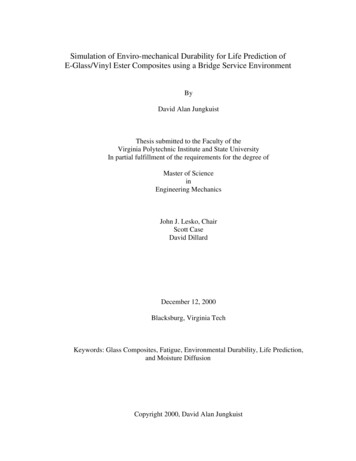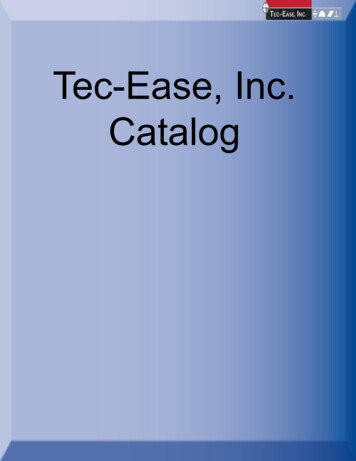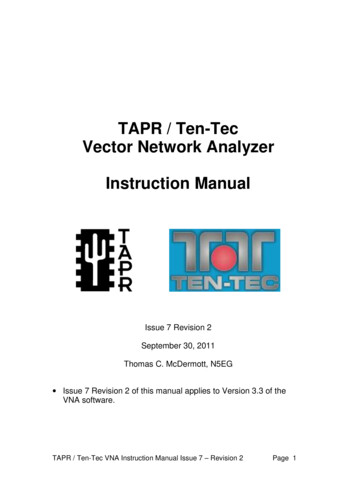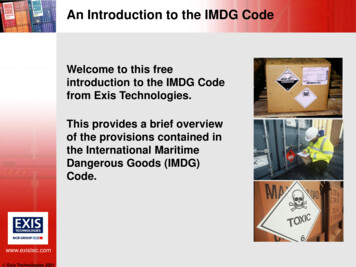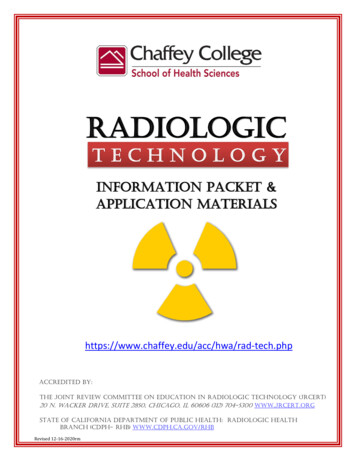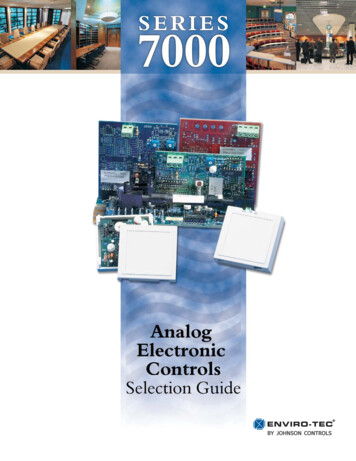
Transcription
ENVIRO-TEC TABLEOFCONTENTSAnalog Electronic vs. DDC Controls Comparison .3Series 7000 Pressure Independent System.5ComponentsPressure Independent Master Controller.7Heat / Fan Modules .8Setback / Warm-Up Modules .9Flow Control Modules.10Field DevicesAnalog Electronic Thermostat .11Air Pressure Switch.12Transformer .12Duct Temperature Sensor .13Floating Point Control Direct Coupled Actuator .13Airflow Ranges .13Series 7000 Calibration Chart .14Control SequencesSingle and Dual Duct Constant Volume and Static PressureControl Sequence Table .15Series Flow Fan Powered (Continuous Fan)Control Sequence Table .16Parallel Flow Fan Powered (Intermittent Fan)Control Sequence Table .17Special Applications.18Guide Specifications .19GENERAL NOTES 2All data herein is subject to change without notice. Refer to www.enviro-tec.com for current catalog andcontrol sequence drawings.Refer to IOM manual at www.enviro-tec.com.Refer to Series 7000 Application Guide and sequence drawings at www.enviro-tec.com.See Analog Electronic Controls drawings at www.enviro-tec.com for connections.Johnson Controls
ELECTRONIC CONTROLS SERIES 7000ANALOG VARIABLE AIR VOLUME TERMINAL CONTROLSARE A COST EFFECTIVE ALTERNATIVE TO DDC CONTROLSFierce competition motivatescommercial office building ownersand real estate managers toprovide comfortable office spacewhile minimizing air conditioningpower consumption and initialconstruction costs. Direct DigitalControls (DDC) are frequentlymounted on each variable airvolume (VAV) terminal, permittingcommunication between theautomation system centralmonitor and each VAV unit. Stateof-the-art Analog Electronic Controls(AEC) for VAV terminals provide aviable lower cost alternative toDDC control.Both sophisticated, solid stateAnalog Electronic and DDC VAVcontrollers provide superior zonecomfort by minimizing roomtemperature deviation fromsetpoint. Both systems permit nightsetback and morning warm-upoperation. Both allow the user tofactory and/or field set minimumand maximum airflow settings.Both provide pressure independent control. Neither requiresannual calibration as do theproportional pneumatic controllers.In view of the cost differencebetween Analog Electroniccontrollers and DDC controllers(see tables at right), when shouldthe owner and HVAC systemdesigner use DDC VAV control?DDC control systems provide twoway communications between theVAV terminal controllers and theautomation system front end. Abuilding manager, from his office,can view zone temperatures,VAV unit operating status, zoneairflow rates, and zone heating andcooling setpoints. He can resetzone temperature setpoints andJohnson ControlsWhat is the First Cost Premium for DDCCommunications Between VAV Terminalsand the Building Automation Front End?The VAV controller type significantly impacts the building cost. TheVAV controller contributes between .21 and 1.44 per square footto the initial cost of a building. The first cost of a DDC VAV controller is more than the cost of the VAV single zone terminal. Theanalog VAV control is less than half the cost of the DDC control.DDC VS. ANALOG CONTROL COSTSAnalog Controls DDC ControlsController & Thermostat 152 257Wiring & Setup 40 175Total 192 432VAV CONTROLS COST PER SQUARE FOOTAnalog ControlsAverageZone AreaCost perSquare FootDDC Controls300 Sq. Ft. 900 Sq. Ft. 300 Sq. Ft. 900 Sq. Ft. .64 .21 1.44 .48ENVIRO-TEC electronic analog andDDC controllers arequality tested for 24hours prior to finalassembly within aNEMA 1 enclosurewith transformerand unit safeties.All terminal unitsand control assemblies are ETL listed with the electronic controllers factory mounted.ENVIRO-TEC onboard transducers and FlowStarTM airflow sensors are capable of accurately controlling at lower airflow rates than typically availablein the industry.3
SERIES 7000 ELECTRONIC CONTROLSminimum and maximum airflowlimits. Zone controllers can sendan alarm to the central monitorwhen abnormal conditions arise.These are powerful tools whichmeet requirements for some owners and tenants.However, for the typical officespace, the owner may find it morecost effective to limit DDC building automation to large chillers,boilers, major air handling units,fire and life safety systems, andother critical applications.For non-critical zones, VAV zoneterminals may only require AnalogElectronic Controllers with systeminterlock controls. The VAVAnalog Electronic Controls have thesame dependability and accuracyas DDC Controls. They also allowthe minimum and maximum CFMsetpoints to be adjusted from thelocal space thermostat for ease ofbalancing the airside of the HVACsystem. In addition, the Series7000 Analog Electronic Controlsincorporate a plug-in modulardesign for ease of adding featuressuch as morning warm-up, nightset back and additional stagesof heat, without replacing theoriginal master controller.Communications wiring for DDCcontrollers may become prohibitive when great distances or remotebuildings are involved. In thosecases, stand-alone Analog ElectronicControls may be the only practical choice.Commissioning DDC VAV systemsrequires factory trained staff familiar with DDC hardware andsoftware, increasing the installedcosts of DDC systems. The operatingcost also increases because theowner has to employ highly trainedtechnicians to maintain the systemor pay for expensive yearly4maintenance contracts from thelocal con tr o l s m a n u f a ctu r erepresentative.When renovating buildings thathave pneumatic controls or expanding campuses that have long usedpneumatic VAV controls, the ownershould consider replacing thepneumatic controls with AnalogElectronic VAV Controls. AnalogElectronic VAV Controls enjoyseveral advantages over theirpneumatic counterparts withapproximately the same initialinstalled first cost. Analog controls eliminate the firstcost of air compressors, filters anddriers. Analog controls, unlike pneumatic, do not require annualcalibration of thermostat andcontrollers. Air compressor, pneumatic piping and filter/drier maintenanceand operating costs are eliminated. Analog controllers maintain spacetemperatures within plus orminus 1 F which providesbetter comfort and greaterenergy efficiency than pneumatic controllers.Many VAV system renovations areaccomplished without replacing thesheet metal VAV terminals.Control system problems, such asmalfunctioning VAV controllersand oil and water in pneumatictubing, often have rendered aVAV system inoperable. Failure toannually calibrate pneumaticcontrols can also render the VAVsystem inoperable. In theseinstances, the system can berepaired by changing only thecontrols. Pressure dependentsystems can be upgraded to apressure independent systems byadding duct airflow sensor kits.Savings to the owner can besubstantial. VAV terminals andductwork are reused. Disturbanceof the ceiling is minimal. Thecontrols retrofit is done in afraction of the time that a completerenovation might take.Conclusion:Stand-alone, Analog ElectronicVAV Controllers offer the samereliability and low maintenance asDDC controls at a much loweroperating and first cost. In addition,analog electronic controls requireonly a standard volt/ohms multimeter for setup and calibration,whereas DDC controls require a laptop or PC computer with expensivesoftware and in many cases, costly specialized product training.One of the only advantages ofthe DDC alternative, is the communication with the PC workstationfront end. As building owners anddesigners develop new projectsand renovate existing properties,careful economic analysis will berequired when selecting betweenAnalog Electronic and communicating DDC control systems.ENVIRO-TEC electronic control retrofitkits facilitate field renovations of existing VAV terminals. All electronic analogcontrol sequences include NEMA 1enclosures and transformers. Model RFTMS airflow sensors and flow sensingstations are available when renovatingpressure dependent systems and converting to pressure independent control.ENVIRO-TEC retrofit control kits can beinstalled on the existing VAV terminalsof most manufacturers.Johnson Controls
ELECTRONIC CONTROLS SERIES 7000SERIES 7000 MODULAR, PRESSURE INDEPENDENT VAV CONTROL SYSTEMThe heart of the Series 7000 Control System is the master controller.It incorporates a differential pressure transducer, airflow controland air valve modulation circuitry,and a DC power supply. With athermostat and actuator, it servesas a stand-alone cooling only, pressure independent VAV controlsystem. The master controller alsoincludes connectors to allow modules to be added in the factory orfield to configure the system forvarious types of terminals: singleor dual duct, series flow or variablevolume fan. Other standard optionsare discussed below.FLOW SENSING METHODA center averaging differentialpressure sensor (FlowStarTM) located in the inlet collar of the VAVterminal is piped to a hot wiredifferential pressure transducerlocated within the electroniccontroller. A small orifice in thetransducer creates a minute airflowwhich is proportional to thedifferential pressure. This flowpasses over a hot thermistor,causing an increase in dissipationand increasing its resistance. Sincecooler air would also have theeffect of increasing resistance, asecond thermistor is incorporatedfor temperature compensation.The electronic circuitry causes aconstant difference in resistance(temperature) between the twothermistors by increasing power tothe hot thermistor as flow increases, and decreasing power to the hotthermistor as flow decreases. Thepower required to maintain thisconstant difference is the parameterused for flow control.Johnson ControlsAIR VALVE CONTROLThe electronic signal developedby the differential pressure transducer is compared to a signaldeveloped from a rapid responsethermistor within the electronicthermostat. Setpoint correspondsto the minimum flow limit set atthe thermostat. The electroniccontroller modulates the air valveactuator from minimum flow tomaximum flow (also set at thethermostat) to provide cooling asnecessary to maintain spacetemperature. As the actual airflowapproaches airflow setpoint, theactuator control circuitry uses pulsewidth modulation (PWM) to slowthe rate of change of the airflow,thus preventing overshoot andhunting. A calibration curve of DCvoltage vs. CFM is provided sothat flow limits may be set without actual airflow being present.Two methods of reverse fan rotation are provided on series flow fanterminals. If system air is failed, theprimary air valve is closed and thefan is de-energized to prevent reapplication of air from spinning thefan wheel in reverse before the fanrestarts. On application of powerto the terminal, the primary air valveis closed for three to five minutesbefore the fan is started, in caseprimary air had spun the fan wheelin reverse before the fan terminalwas powered.HEAT / FAN CONTROLFour types of heat and two typesof fan control are available with theSeries 7000. Heat options includestaged electric or hot water,floating modulating hot water,proportional modulating hot wateror proportional modulating SSRelectric heat. Either terminal and/orbaseboard heat may be controlled.In floating modulating applications, the valve actuator is pulsedin the open direction when thespace temperature reaches twodegrees below setpoint. If thetemperature continues to fall, thevalve actuator is pulsed again in theopen direction. If the temperaturedoes not decrease, the valveactuator is not energized, thusremaining in position. On anincrease in space temperature, thevalve actuator is pulsed in theclosed direction. The length of thepulses is proportional to thetemperature difference from twodegrees below setpoint.Both variable volume and seriesflow fan control strategies areavailable. For variable volumeapplications, the unit fan is energized one degree below setpoint.A half degree of hysteresis preventsrapid cycling. For series flow applications, the fan runs constantlyduring day mode.For staged heat applications, astage of electric or hot water heatis energize
VAV controller contributes between .21 and 1.44 per square foot to the initial cost of a building. The first cost of a DDC VAV con-troller is more than the cost of the VAV single zone terminal. The analog VAV control is less than half the cost of the DDC control. What is the First Cost Premium for DDC Communications Between VAV Terminals and the Building Automation Front End? Analog Controls .
